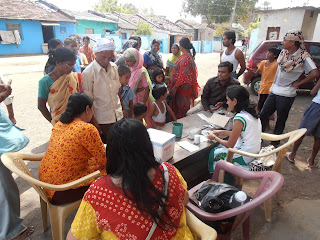I haven’t been doing the best job of keeping the blog
updated this trip but our internet was crappy in Nagpur and we were super busy
and exhausted at the end of every day. Everyone pretty much works 24/7 at the
hospital which is why we were ready to leave at 7am for a community camp in a
village about 45 minutes away near the Dragon Palace Temple. Sanjeewani and Dr.
Amol went to set everything up for the camp while my sister, Sheetal and I
explored the Dragon Palace Temple.
 |
| Walking up to the entrance to the temple |
The Dragon Palace Temple is a Buddhist temple in Kamptee,
Nagpur and is gorgeous! It kind of looks out of place among all the other
buildings in the area but the architecture is gorgeous and so is the
landscaping. Apparently at one point in time the Dragon Palace won an
International Award for the best concrete structure in the world. It was super
clean which is a rarity but it would be depressing if the temple very became
run down and dirty like a lot of other places in India. There is a large Buddha
statue inside and it is said that the statue was carved out of a single block
of sandalwood and I believe it was brought over from Japan. The exterior color
of the temple is white which is supposed to symbolize calmness, clarity, and
divinity. The temple is also sometimes referred to as the Lotus Temple of
Nagpur which I guess you can kind of see somewhat with the structure of the
temple. Maybe an aerial view shows more of a Lotus shape?
This statue was off to the left side of the temple explaining why the temple was built
Anyway, the Dragon Palace was definitely a unique place to
visit during our trip. There is a large Buddhist community in this area which I’ll
explain a little bit more later. After exploring the temple we headed to the
village where the community screening camp was set up.
 |
| Sanjeewani talking to everyone in the community |
The Sickle Cell Team from the hospital goes to various
villages surrounding Nagpur to offer community screening. Over a 3 hour period,
102 individuals were screened using a Sickle Prep test which will indicate the
presence of the sickle gene but not necessarily the genotype. Around 12 were
found positive so these twelve individuals then had their blood drawn for HPLC
analysis. Sanjeewani started the morning by explaining to the group gathered
the purpose of the visit and explaining about Sickle Cell Anemia why screening
is important and the implications of a positive result.
 |
| Our set up for the camp |
It was interesting to
see that throughout the screenings if an individual was found to be positive
there was no private disclosure. The name of the individual who tested positive
was called out and Sanjeewani would tell that person in front of everyone that
they tested positive and that they needed to go get any other family members
that were at home so that they could be tested. This method of disclosure meant
that the entire community was privy to learn about others test results if they
were around when the name was called out. Definitely goes against everything we
do in the States but that is the way of life here.
 |
| Sheetal doing the initial Sickle Prep test on all the individuals |
These screening camps kind of reminded me of the community screening events that Children’s Hospital and the Children’s Sickle Cell Foundation offer in areas with a high African American population in Pittsburgh. While we don’t do immediate disclosures we do offer free screening and offer counseling for the individuals interested in testing.
 |
| Dr. Amol drawing blood from a boy that tested positive on the prep test |
After completing the screening camp we stopped for lunch on
the way back to Dr. Jain’s house for some amazing Paneer and paratha J
 |
| Dheekshabhoomi |
Dr. Jain had Rakshit, the driver, take us to a few more
places in Nagpur because she got called in for an emergency at the hospital.
First we went to Deekshabhoomi which is
the place where Dr. Ambedkar converted to Buddhism with close to 400,000 of his
followers in October of 1956. The monument at Deekshaboomi is a pilgrimage
center of Buddhism in India. The name Deekshabhoomi comes from Deeksha which
literally means accepting religion and Bhoomi which means land. So Deekshabhoomi
means the land where people get converted to Buddhism (Buddhism advocates the
acceptance of all religions).
 |
| We got to see a gorgeous sunset |
From here we then drove to a nearby lake to watch the sunset
and take in the scenery and on the drive back to the house we drove by a “pole”
which represents the precise geographic center of India. It’s interesting that
there are statues of Dr. Ambedkar all over the city, the airport is named after
him, and so are a number of educational institutions but there’s nothing but a
lousy pole to signify the geographic center of the entire country.
It was definitely nice to do a little sight-seeing today and
explore Nagpur a bit. J


No comments:
Post a Comment